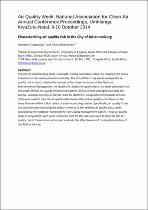JavaScript is disabled for your browser. Some features of this site may not work without it.
- ResearchSpace
- →
- Research Publications/Outputs
- →
- Conference Publications
- →
- View Item
| dc.contributor.author |
Ngwenya, NS

|
|
| dc.contributor.author |
Thambiran, Tirusha

|
|
| dc.date.accessioned | 2015-10-16T05:47:10Z | |
| dc.date.available | 2015-10-16T05:47:10Z | |
| dc.date.issued | 2014-10 | |
| dc.identifier.citation | Ngwenya, N.S. and Thambiran, T. 2014. Characterising air quality risk in the City of Johannesburg. Air Quality Week: National Association for Clean Air Annual Conference Proceedings, Umhlanga, KwaZulu-Natal, 8-10 October 2014 | en_US |
| dc.identifier.isbn | 978-0-620-63064-1 | |
| dc.identifier.uri | http://www.naca.org.za/uploads/NACA%20programme%202014.pdf | |
| dc.identifier.uri | http://hdl.handle.net/10204/8194 | |
| dc.description | Air Quality Week: National Association for Clean Air Annual Conference Proceedings, Umhlanga, KwaZulu-Natal, 8-10 October 2014. Due to copyright restrictions, the attached PDF file only contains the abstract of the full text item. For access to the full text item, please consult the publisher's website | en_US |
| dc.description.abstract | The City of Johannesburg (CoJ) is characterized by numerous industries ranging from heavy industries to the service provision industry. The aim of this study was to analyse the air quality risk in the CoJ within the context of the implementation of the National Environmental Management: Air Quality Act (AQA). Air quality data that were obtained from the South African Air Quality Information System (SAAQIS) were averaged such that the diurnal, seasonal and annual trends could be identified. Geographic Information Systems (GIS) were used to map the air quality data availability and air quality compliance in the areas that are within a 3km radius of each monitoring station. Specifically, air quality in the city was characterised using the colour schemes of the ambient air quality class zones provided by the National Framework for Air Quality Management (2007). These air quality maps in conjunction with socio-economic data for the CoJ were used to describe the air quality risk of these communities and evaluate the effectiveness of the implementation of the AQA in the city. | en_US |
| dc.language.iso | en | en_US |
| dc.publisher | NACA | en_US |
| dc.relation.ispartofseries | Workflow;14762 | |
| dc.subject | Air quality management | en_US |
| dc.subject | Air quality act | en_US |
| dc.subject | Air quality risk | en_US |
| dc.subject | City of Johannesburg | en_US |
| dc.title | Characterising air quality risk in the City of Johannesburg | en_US |
| dc.type | Conference Presentation | en_US |
| dc.identifier.apacitation | Ngwenya, N., & Thambiran, T. (2014). Characterising air quality risk in the City of Johannesburg. NACA. http://hdl.handle.net/10204/8194 | en_ZA |
| dc.identifier.chicagocitation | Ngwenya, NS, and Tirusha Thambiran. "Characterising air quality risk in the City of Johannesburg." (2014): http://hdl.handle.net/10204/8194 | en_ZA |
| dc.identifier.vancouvercitation | Ngwenya N, Thambiran T, Characterising air quality risk in the City of Johannesburg; NACA; 2014. http://hdl.handle.net/10204/8194 . | en_ZA |
| dc.identifier.ris | TY - Conference Presentation AU - Ngwenya, NS AU - Thambiran, Tirusha AB - The City of Johannesburg (CoJ) is characterized by numerous industries ranging from heavy industries to the service provision industry. The aim of this study was to analyse the air quality risk in the CoJ within the context of the implementation of the National Environmental Management: Air Quality Act (AQA). Air quality data that were obtained from the South African Air Quality Information System (SAAQIS) were averaged such that the diurnal, seasonal and annual trends could be identified. Geographic Information Systems (GIS) were used to map the air quality data availability and air quality compliance in the areas that are within a 3km radius of each monitoring station. Specifically, air quality in the city was characterised using the colour schemes of the ambient air quality class zones provided by the National Framework for Air Quality Management (2007). These air quality maps in conjunction with socio-economic data for the CoJ were used to describe the air quality risk of these communities and evaluate the effectiveness of the implementation of the AQA in the city. DA - 2014-10 DB - ResearchSpace DP - CSIR KW - Air quality management KW - Air quality act KW - Air quality risk KW - City of Johannesburg LK - https://researchspace.csir.co.za PY - 2014 SM - 978-0-620-63064-1 T1 - Characterising air quality risk in the City of Johannesburg TI - Characterising air quality risk in the City of Johannesburg UR - http://hdl.handle.net/10204/8194 ER - | en_ZA |






